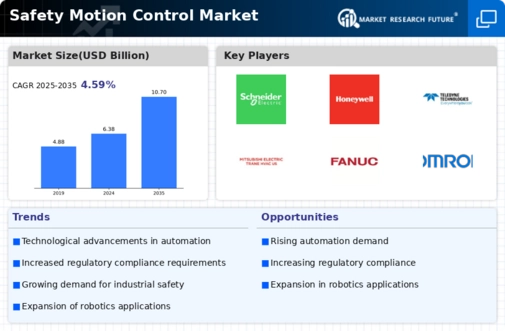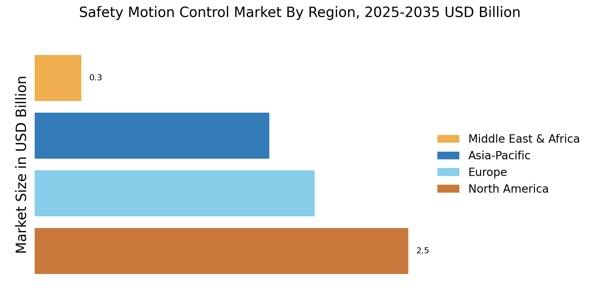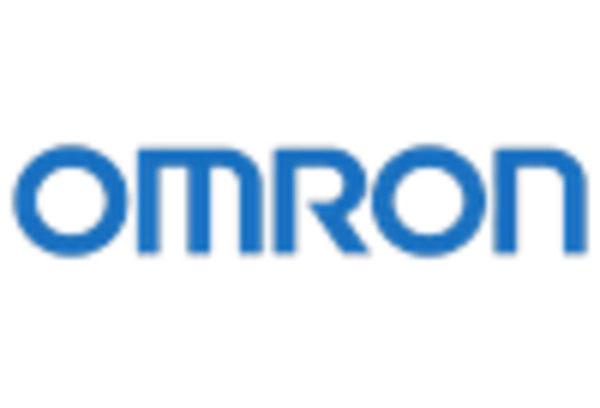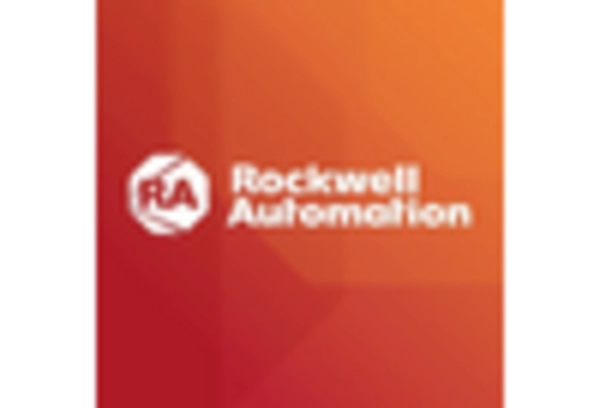Growth of Automation in Manufacturing
The growth of automation in manufacturing is significantly influencing the Safety Motion Control Market. As industries increasingly adopt automated processes to enhance productivity and efficiency, the need for reliable safety motion control systems becomes more pronounced. Automation not only streamlines operations but also introduces new safety challenges that require advanced motion control solutions. The market is projected to expand as manufacturers seek to integrate safety features into their automated systems. Recent studies indicate that the automation sector is expected to grow at a rate of 8% annually, further driving the demand for safety motion control technologies. This trend highlights the necessity of ensuring safety in automated environments, thereby fostering market development.
Regulatory Compliance and Safety Standards
Regulatory compliance and adherence to safety standards are pivotal drivers of the Safety Motion Control Market. Governments and regulatory bodies worldwide are implementing stringent safety regulations to protect workers and minimize accidents in industrial settings. Compliance with these regulations often necessitates the adoption of advanced safety motion control solutions. As industries strive to meet these standards, the demand for safety motion control technologies is expected to rise. Recent data suggests that companies investing in compliance-related technologies experience a reduction in workplace incidents by up to 30%. This trend underscores the importance of safety motion control systems in achieving regulatory compliance, thereby propelling market growth.
Increased Investment in Worker Safety Initiatives
Increased investment in worker safety initiatives is a significant driver of the Safety Motion Control Market. Organizations are recognizing the long-term benefits of prioritizing employee safety, leading to enhanced productivity and reduced liability costs. This shift in focus has resulted in a marked increase in funding for safety motion control technologies. Recent reports indicate that companies are allocating up to 15% of their operational budgets towards safety improvements, which includes the implementation of advanced motion control systems. This trend not only reflects a commitment to worker safety but also indicates a growing recognition of the economic advantages associated with investing in safety technologies. As such, the Safety Motion Control Market is likely to experience sustained growth as organizations continue to prioritize safety initiatives.
Rising Demand for Safety in Industrial Operations
The increasing emphasis on safety in industrial operations is a primary driver for the Safety Motion Control Market. As industries expand and evolve, the need for robust safety measures becomes paramount. In recent years, the market has witnessed a surge in demand for safety motion control solutions, with projections indicating a compound annual growth rate of approximately 7% through 2028. This growth is largely attributed to the rising awareness of workplace safety and the potential for accidents in manufacturing environments. Companies are investing in advanced safety motion control technologies to mitigate risks and enhance operational efficiency. The integration of these technologies not only ensures compliance with safety regulations but also fosters a culture of safety within organizations, thereby driving the market forward.
Technological Advancements in Motion Control Systems
Technological advancements play a crucial role in shaping the Safety Motion Control Market. Innovations in sensor technology, artificial intelligence, and machine learning are transforming traditional motion control systems into more intelligent and responsive solutions. These advancements enable real-time monitoring and predictive maintenance, which significantly enhance safety protocols. For instance, the introduction of smart sensors allows for immediate detection of anomalies, thereby preventing potential hazards. The market is expected to grow as manufacturers increasingly adopt these advanced technologies, with estimates suggesting a market value exceeding 5 billion by 2026. This trend indicates a shift towards more sophisticated safety motion control systems that not only comply with existing regulations but also anticipate future safety challenges.


















Leave a Comment